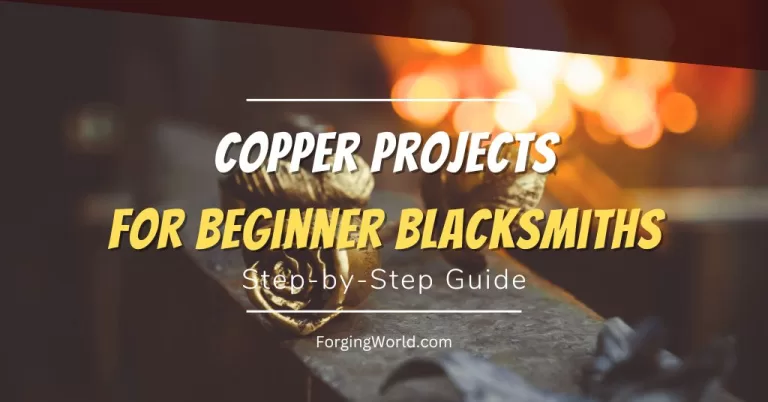The ball peen hammer is a versatile tool that deserves a spot in every blacksmith’s and bladesmith’s arsenal.
While it may not be as common as other types of hammers in blacksmithing, the ball peen hammer has unique applications that can add value to your forging projects.
In this article, we’ll cover the basics of using a ball peen hammer, offering practical tips, advice, and examples to help you get the most out of this essential tool.
What is a Ball Peen Hammer?
A ball peen hammer features a flat face on one side and a round, ball-shaped peen on the other. This design makes it well-suited for tasks like peening (hardening) the surface of metal, creating dimples or textures, and riveting.
While it may not be the first hammer you reach for in blacksmithing, its unique properties make it a valuable addition to your toolkit.
How to Use a Ball Peen Hammer: Techniques and Tips
The ball peen hammer is a versatile tool with a range of applications in blacksmithing and bladesmithing.
In this section, we’ll explore various techniques and tips to help you make the most of your ball peen hammer.
Peening: Strengthening and Shaping Metal
Peening is a technique used to harden the surface of metal, improve its appearance, and reduce the risk of cracking.
Here’s a step-by-step guide on how to peen using a ball peen hammer:
- Secure the metal: Ensure the metal piece is firmly secured, either in a vise or using tongs.
- Position the hammer: Hold the hammer with the ball-peen side facing the metal surface. Maintain a comfortable grip on the handle, and ensure your wrist is relaxed for better control.
- Strike the metal: Begin by striking the metal gently, creating a series of overlapping dimples. Gradually increase the force of your strikes as you become more comfortable with the process. Be sure to cover the entire surface evenly.
Cold Peening vs. Hot Peening
Cold peening is done at room temperature and can help remove surface imperfections, while hot peening is performed on heated metal, allowing for better surface hardening and reduced stress concentrations. Choose the appropriate method based on your project requirements.
Texturing: Creating Unique Patterns and Finishes
The ball peen hammer can be used to create unique textures on metal surfaces, adding visual interest and depth to your work. Here are some tips to get started:
- Experiment with angles: Vary the angle at which you strike the metal to create different textures and patterns.
- Control the force: Adjust the force of your strikes to create more pronounced or subtle textures.
- Combine techniques: Mix peening with other texturing techniques, like chiseling or engraving, to achieve a truly one-of-a-kind finish.
Riveting: Joining Metal Pieces Together
The ball peen hammer is ideal for creating rivets, which can be used to join two pieces of metal securely. Here’s how to rivet using a ball peen hammer:
- Drill a hole: Drill a hole through the pieces of metal you want to join.
- Insert the rivet: Place the rivet in the hole, ensuring it protrudes slightly on both sides.
- Flatten one end: Using the flat face of the hammer, flatten one end of the rivet to secure the metal pieces.
- Shape the other end: Switch to the ball-peen side of the hammer and gently tap the other end of the rivet to create a rounded, mushroom-like shape.
Planishing: Smoothing Out Metal Surfaces
The ball peen hammer can also be used for planishing, a technique that involves smoothing out metal surfaces by striking them with the flat face of the hammer. This can be useful for removing hammer marks or creating a polished finish on your work.
When planishing, be sure to work methodically and evenly to avoid creating new imperfections.
Ball Peen Hammer Safety Tips
When working with any hammer, safety should be a top priority. Keep these ball peen hammer safety tips in mind:
- Always wear safety glasses to protect your eyes from flying debris.
- Use a secure grip on the hammer handle, but avoid gripping too tightly, as this can cause hand fatigue and reduce control.
- Ensure your workspace is clean and free from tripping hazards.
- Inspect your hammer for damage before each use, and replace the handle if it becomes loose or cracked.
Choosing the Right Ball Peen Hammer
Ball peen hammers come in various sizes and weights, so it’s essential to choose the right one for your needs.
For a detailed guide on selecting the best ball peen hammer, check out our article on the best ball peen hammers.
Final Thoughts
The ball peen hammer may not be the most common hammer in blacksmithing, but it certainly has a unique set of applications that can add value to your forging projects. From peening to texturing and riveting, this versatile tool offers a lot of functionalities.
With proper technique, safety measures and regular inspection, the ball peen hammer is an excellent addition to any blacksmith’s or bladesmith’s tool collection.
Whether you’re a beginner or an experienced professional, learning how to use this tool can offer endless possibilities for creativity in metalworking.
So, start practicing and exploring the many uses of the ball peen hammer today!


